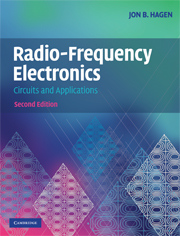Book contents
- Frontmatter
- Contents
- Preface
- 1 Introduction
- 2 Impedance matching
- 3 Linear power amplifiers
- 4 Basic filters
- 5 Frequency converters
- 6 Amplitude and frequency modulation
- 7 Radio receivers
- 8 Suppressed-carrier AM and quadrature AM (QAM)
- 9 Class-C, D, and E Power RF amplifiers
- 10 Transmission lines
- 11 Oscillators
- 12 Phase lock loops and synthesizers
- 13 Coupled-resonator bandpass filters
- 14 Transformers and baluns
- 15 Hybrid couplers
- 16 Waveguide circuits
- 17 Small-signal RF amplifiers
- 18 Demodulators and detectors
- 19 Television systems
- 20 Antennas and radio wave propagation
- 21 Radar
- 22 Digital modulation techniques
- 23 Modulation, noise, and information
- 24 Amplifier and oscillator noise analysis
- 25 The GPS Navigation system
- 26 Radio and radar astronomy
- 27 Radio spectrometry
- 28 S-parameter circuit analysis
- 29 Power supplies
- 30 RF test equipment
- Index
10 - Transmission lines
Published online by Cambridge University Press: 05 June 2012
- Frontmatter
- Contents
- Preface
- 1 Introduction
- 2 Impedance matching
- 3 Linear power amplifiers
- 4 Basic filters
- 5 Frequency converters
- 6 Amplitude and frequency modulation
- 7 Radio receivers
- 8 Suppressed-carrier AM and quadrature AM (QAM)
- 9 Class-C, D, and E Power RF amplifiers
- 10 Transmission lines
- 11 Oscillators
- 12 Phase lock loops and synthesizers
- 13 Coupled-resonator bandpass filters
- 14 Transformers and baluns
- 15 Hybrid couplers
- 16 Waveguide circuits
- 17 Small-signal RF amplifiers
- 18 Demodulators and detectors
- 19 Television systems
- 20 Antennas and radio wave propagation
- 21 Radar
- 22 Digital modulation techniques
- 23 Modulation, noise, and information
- 24 Amplifier and oscillator noise analysis
- 25 The GPS Navigation system
- 26 Radio and radar astronomy
- 27 Radio spectrometry
- 28 S-parameter circuit analysis
- 29 Power supplies
- 30 RF test equipment
- Index
Summary
We draw circuit diagrams with “lumped”components: ideal R's, C's, L's, transistors, etc., connected by lines that represent zero-length wires. But all real wires, if not much shorter than the shortest relevant wavelength, are themselves complicated circuit elements; the current is not the same everywhere along such a wire, nor is voltage uniform, even if the wire has no resistance. On the other hand, when interconnections are made with transmission lines, which are well-understood circuit elements, we can accurately predict circuit behavior. In this section we will consider two-conductor lines such as coaxial cables and open parallel wire lines. “Microstrip lines” (conducting metal traces on an insulation layer over a metal ground plane) behave essentially in the same way, but they have some subtle complications, which are mentioned in Appendix 10.1.
Characteristic impedance
The first thing one learns about transmission lines is that they have a parameter known as characteristic impedance, denoted Z0. How “real” is characteristic impedance? If we connect an ordinary dc ohmmeter to the end of a 50-ohm cable will it indicate 50 ohms? Yes, if the cable is very long, so that a reflection from the far end does not arrive back at the meter before we finish the measurement. Otherwise, the meter will simply measure whatever is connected to the far end, which could be short, an open circuit, or a resistance.
- Type
- Chapter
- Information
- Radio-Frequency ElectronicsCircuits and Applications, pp. 101 - 119Publisher: Cambridge University PressPrint publication year: 2009



